Eastern Orthodoxy
 From Wikipedia the free encyclopedia
From Wikipedia the free encyclopedia
| Part of a series on |
| Eastern Christianity |
|---|
 |
| Part of a series on |
| Christianity |
|---|
 |
Eastern Orthodoxy, otherwise known as Eastern Orthodox Christianity or Byzantine Christianity,[1] is one of the three main branches of Chalcedonian Christianity, alongside Catholicism and Protestantism.[2][3] Like the Pentarchy of the first millennium, the mainstream (or "canonical") Eastern Orthodox Church is organised into autocephalous churches independent from each other. In the 21st century, the number of mainstream autocephalous churches is seventeen; there also exist autocephalous churches unrecognized by those mainstream ones. Autocephalous churches choose their own primate. Autocephalous churches can have jurisdiction (authority) over other churches, some of which have the status of "autonomous" which means they have more autonomy than simple eparchies.
Many of these jurisdictions correspond to the territories of one or more modern states; the Patriarchate of Moscow, for example, corresponds to Russia and some of the other post-Soviet states.[4] They can also include metropolises, bishoprics, parishes, monasteries, or outlying metochions corresponding to diasporas that can also be located outside the country where the primate resides (e.g., the case of the Ecumenical Patriarchate of Constantinople whose canonical territory is located partly in northern Greece and the east); sometimes they overlap (the case of Moldova where the jurisdictions of the patriarchs of Bucharest and of Moscow overlap).
The spread of Eastern Orthodoxy began in the eastern area of the Mediterranean Basin within Byzantine Greek culture.[1] Its communities share an understanding, teaching and offices of great similarity, with a strong sense of seeing each other as parts of one Church. Adherents of Eastern Orthodox Christianity sees their year punctuated by the liturgical calendar of the church on which they depend. Eastern Orthodoxy holds that the Holy Spirit proceeds from the Father and rejects the Filioque clause ("and the Son") added to the Nicene Creed by the Latin Church, on the grounds that no council was called for the addition.[5]
Theology
[edit]Trinity
[edit]Eastern Orthodox Christians believe in the Trinity, three distinct, divine persons (hypostases), without overlap or modality among Them, Who each fully share in one divine essence (ousia, Greek: οὐσία)—uncreated, immaterial, and eternal.[6] These three persons are typically distinguished by their relation to each other. The Father is eternal, neither begotten nor proceeding from any, the Son is eternal and begotten of the Father, and the Holy Spirit is eternal and proceeds from the Father.[7] Eastern Orthodox doctrine regarding the Trinity is summarised in the Greek edition of the Nicene Creed, which notably does not affirm the Filioque.[8]
Eastern Orthodox Christians believe in a monotheistic conception of God (God is only one), which is both transcendent (wholly independent of, and removed from, the material universe) and immanent (involved in the material universe).[7] In discussing God's relationship to His creation, Eastern Orthodox theology distinguishes between God's eternal essence, which is totally transcendent, and His uncreated energies, which is how He reaches humanity.[7] The God who is transcendent and the God who touches mankind are one and the same.[7] That is, these energies are not something that proceed from God or that God produces, but rather they are God himself: distinct, yet inseparable from God's inner being.[9] This view is often called Palamism.
In understanding the Trinity as "one God in three persons", "three persons" is not to be emphasised more than "one God", and vice versa. While the three persons are distinct, they are united in one divine essence, and Their oneness is expressed in community and action so completely that They cannot be considered separately. For example, Their salvation of mankind is an activity engaged in common: "Christ became man by the good will of the Father and by the cooperation of the Holy Spirit. Christ sends the Holy Spirit who proceeds from the Father, and the Holy Spirit forms Christ in our hearts, and thus God the Father is glorified." Their "communion of essence" is "indivisible". Trinitarian terminology—essence, hypostasis, etc.—are used "philosophically", "to answer the ideas of the heretics", and "to place the terms where they separate error and truth".[10]
Sin, salvation, and the incarnation
[edit]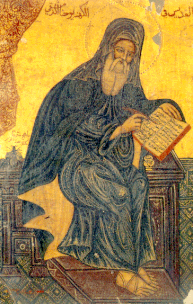
When Eastern Orthodox Christians refer to "fallen nature", they do not mean that human nature has become evil in itself. Human nature is still formed in the image of God; humans are still God's creation, and God has never created anything evil, but fallen nature remains open to evil intents and actions. It is sometimes said among the Eastern Orthodox that humans are "inclined to sin"; that is, people find some sinful things attractive. It is the nature of temptation to make sinful things seem the more attractive, and it is the fallen nature of humans that seeks or succumbs to the attraction. Eastern Orthodox Christians reject the Augustinian position that the descendants of Adam and Eve are actually guilty of the original sin of their ancestors.[11]
Resurrection of Christ
[edit]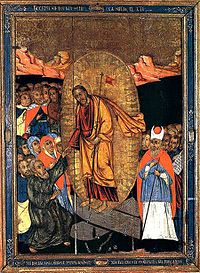
The Eastern Orthodox Church understands the death and resurrection of Jesus to be real historical events, as described in the gospels of the New Testament.[12][13]
Christian life
[edit]Church teaching is that Eastern Orthodox Christians, through baptism, enter a new life of salvation through repentance whose purpose is to share in the life of God through the work of the Holy Spirit. The Eastern Orthodox Christian life is a spiritual pilgrimage in which each person, through the imitation of Christ and hesychasm,[14] cultivates the practice of unceasing prayer. Each life occurs within the life of the church as a member of the body of Christ.[15] It is then through the fire of God's love in the action of the Holy Spirit that each member becomes more holy, more wholly unified with Christ, starting in this life and continuing in the next.[16][17] The church teaches that everyone, being born in God's image, is called to theosis, fulfillment of the image in likeness to God. God the creator, having divinity by nature, offers each person participation in divinity by cooperatively accepting His gift of grace. This isn't to be mistaken as participating in the essence of God but rather participating in His energies. This would mean that we do not become "divine", we still remain human but become "gods" by grace, or in other words "icons of the living God" as many call it. [18]
The Eastern Orthodox Church, in understanding itself to be the Body of Christ, and similarly in understanding the Christian life to lead to the unification in Christ of all members of his body, views the church as embracing all Christ's members, those now living on earth, and also all those through the ages who have passed on to the heavenly life. The church includes the Christian saints from all times, and also judges, prophets and righteous Jews of the first covenant, Adam and Eve, even the angels and heavenly hosts.[19] In Eastern Orthodox services, the earthly members together with the heavenly members worship God as one community in Christ, in a union that transcends time and space and joins heaven to earth. This unity of the Church is sometimes called the communion of the saints.[20]
Virgin Mary and other saints
[edit]
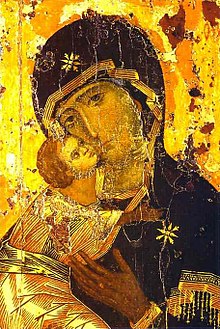
Pre-eminent among the saints is the Virgin Mary (commonly referred to as Theotokos or Bogorodica: "Mother of God"). In Eastern Orthodox theology, the Mother of God is the fulfillment of the Old Testament archetypes revealed in the Ark of the Covenant (because she carried the New Covenant in the person of Christ) and the burning bush that appeared before Moses (symbolising the Mother of God's carrying of God without being consumed).[21]
The Eastern Orthodox believe that Christ, from the moment of his conception, was both fully God and fully human. Mary is thus called the Theotokos or Bogorodica as an affirmation of the divinity of the one to whom she gave birth. It is also believed that her virginity was not compromised in conceiving God-incarnate, that she was not harmed and that she remained forever a virgin. Scriptural references to "brothers" of Christ are interpreted as kin. Due to her unique place in salvation history according to Eastern Orthodox teaching, Mary is honoured above all other saints in this religion and especially venerated for the great work that God accomplished through her.[22]
The Eastern Orthodox Church regards the bodies of all saints as holy because of their participation in prescribed rituals called holy mysteries. Physical items connected with saints are also regarded as holy, through their participation in the earthly works of those saints. According to Eastern Orthodox church teaching and tradition, God himself bears witness to this holiness of saints' relics through the many miracles connected with them that have been reported throughout history since biblical times, often including healing from disease and injury.[23]
Eschatology
[edit]
Eastern Orthodox Christians believe that when a person dies the soul is temporarily separated from the body. Though it may linger for a short period on Earth, it is ultimately escorted either to paradise (Abraham's bosom) or the darkness of Hades, following the Temporary Judgment. Orthodox do not accept the doctrine of Purgatory, which is held by Catholicism. The soul's experience of either of these states is only a "foretaste"—being experienced only by the soul—until the Final Judgment, when the soul and body will be reunited.[24][25]
The Eastern Orthodox believe that the state of the soul in Hades can be affected by the love and prayers of the righteous up until the Last Judgment.[26] For this reason the Church offers a special prayer for the dead on the third day, ninth day, fortieth day, and the one-year anniversary after the death of an Eastern Orthodox Christian. There are also several days throughout the year that are set aside for general commemoration of the departed, sometimes including nonbelievers. These days usually fall on a Saturday, since it was on a Saturday that Christ lay in the Tomb.[25]
The Eastern Orthodox believe that after the Final Judgment:
- All souls will be reunited with their resurrected bodies.
- All souls will fully experience their spiritual state.
- Having been perfected, the saints will forever progress towards a deeper and fuller love of God, which equates with eternal happiness.[25]
Bible
[edit]
The official Bible of the Eastern Orthodox Church contains the Septuagint text of the Old Testament, with the Book of Daniel given in the translation by Theodotion. The Patriarchal Text is used for the New Testament.[27][28] Orthodox Christians hold that the Bible is a verbal icon of Christ, as proclaimed by the 7th ecumenical council.[29] They refer to the Bible as holy scripture, meaning writings containing the foundational truths of the Christian faith as revealed by Christ and the Holy Spirit to its divinely inspired human authors. Holy scripture forms the primary and authoritative written witness of holy tradition and is essential as the basis for all Orthodox teaching and belief.[30]
Once established as holy scripture, there has never been any question that the Eastern Orthodox Church holds the full list[which?] of books to be venerable and beneficial for reading and study,[31] even though it informally holds some books in higher esteem than others, the four gospels highest of all. Of the subgroups significant enough to be named, the "Anagignoskomena" (ἀναγιγνωσκόμενα, "things that are read") comprises ten of the Old Testament books rejected in the Protestant canon,[a] but deemed by the Eastern Orthodox worthy to be read in worship services, even though they carry a lesser esteem than the 39 books of the Hebrew canon.[32] The lowest tier contains the remaining books not accepted by either Protestants or Catholics, among them, Psalm 151. Though it is a psalm, and is in the book of psalms, it is not classified as being within the Psalter (the first 150 psalms).[33]
Eastern Orthodoxy does not subscribe to the doctrine of sola scriptura. Rather, Eastern Orthodoxy teaches that its church has defined what Scripture is, and therefore, its church also interprets the meanings of Scripture.[34]
Scriptures are understood by Eastern Orthodox interpretation to contain historical fact, poetry, idiom, metaphor, simile, moral fable, parable, prophecy and wisdom literature, and each bears its own consideration in its interpretation. While divinely inspired, the text still consists of words in human languages, arranged in humanly recognisable forms. The Eastern Orthodox Church does not oppose honest critical and historical study of the Bible.[35]
Holy tradition and patristic consensus
[edit]In Eastern Orthodoxy, "that faith which has been believed everywhere, always, and by all", the faith taught by Jesus to the apostles, given life by the Holy Spirit at Pentecost, and passed down to future generations without additions and without subtractions, is known as holy tradition.[36][37] Holy tradition does not change in the Eastern Orthodox Church because it encompasses those things that do not change: the nature of the one God in Trinity, Father, Son, and Holy Spirit, the history of God's interactions with his peoples, the Law as given to the Israelites, all Christ's teaching as given to the disciples and Jews and recorded in scripture, including the parables, the prophecies, the miracles, and his own example to humanity in his extreme humility. It encompasses also the worship of the church, which grew out of the worship of the synagogue and temple and was extended by Christ at the last supper, and the relationship between God and his people which that worship expresses, which is also evidenced between Christ and his disciples. It includes the authority that Christ bestowed on his disciples when he made them apostles.[38]
Holy tradition is firm, even unyielding, but not rigid or legalistic; instead, it lives and breathes within the church.[39] For example, the New Testament was entirely written by the early church (mostly the apostles). The whole Bible was accepted as scripture by means of holy tradition practised within the early church. The writing and acceptance took five centuries, by which time the holy scriptures themselves had become in their entirety a part of holy tradition.[40] But holy tradition did not change, because "that faith which has been believed everywhere, always, and by all" remained consistent, without additions, and without subtractions. The historical development of the Divine Liturgy and other worship services and devotional practices of the church provide a similar example of extension and growth "without change".[41]
Besides these, holy tradition includes the doctrinal definitions and statements of faith of the seven ecumenical councils, including the Nicene-Constantinopolitan Creed, and some later local councils, patristic writings, canon law, and icons. Not all portions of holy tradition are held to be equally strong. Some—the holy scriptures foremost, certain aspects of worship, especially in the Divine Liturgy, the doctrines of the ecumenical councils, the Nicene-Constantinopolitan Creed—possess a verified authority that endures forever, irrevocably. However, with local councils and patristic writings, the church applies a selective judgement. Some councils and writers have occasionally fallen into error, and some contradict each other.[35]
In other cases, opinions differ, no consensus is forthcoming, and all are free to choose. With agreement among the Church Fathers, though, the authority of interpretation grows, and full patristic consensus is very strong. With canon law (which tends to be highly rigorous and very strict, especially with clergy) an unalterable validity also does not apply, since canons deal with living on earth, where conditions are always changing and each case is subject to almost infinite variation from the next.[35]
By tradition, the Eastern Orthodox Church, when faced with issues that are larger than a single bishop can resolve, holds a local council. The bishops convene (as St. Paul called the Corinthians to do) to seek the mind of the church.[42] A council's declarations or edicts then reflect its consensus (if one can be found). An ecumenical council is only called for issues of such importance, difficulty or pervasiveness that smaller councils are insufficient to address them. Ecumenical councils' declarations and canons carry binding weight by virtue of their representation across the whole church, by which the mind of the church can be readily seen. However, not all issues are so difficult as to require an ecumenical council to resolve. Some doctrines or decisions, not defined in a formal statement or proclaimed officially, nevertheless are held by the church unshakably and unanimously without internal disturbance, and these, also reflecting the mind of the church, are just as firmly irrevocable as a formal declaration of an ecumenical council. Lack of formality does not imply lack of authority within holy tradition.[35]
Territorial expansion and doctrinal integrity
[edit]As the church increased in size through the centuries, the logistic dynamics of operating such large entities shifted: patriarchs, metropolitans, archimandrites, abbots and abbesses, all rose up to cover certain points of administration.[citation needed]
Liturgy
[edit]
Church calendar
[edit]Lesser cycles also run in tandem with the annual ones. A weekly cycle of days prescribes a specific focus for each day in addition to others that may be observed:[43]
Each day of the Weekly Cycle is dedicated to certain special memorials. Sunday is dedicated to Christ's Resurrection; Monday honors the holy bodiless powers (angels, archangels, etc.); Tuesday is dedicated to the prophets and especially the greatest of the prophets, St. John the Forerunner and Baptist of the Lord; Wednesday is consecrated to the Cross and recalls Judas' betrayal; Thursday honors the holy apostles and hierarchs, especially St. Nicholas, Bishop of Myra in Lycia; Friday is also consecrated to the Cross and recalls the day of the Crucifixion; Saturday is dedicated to All Saints, especially the Mother of God, and to the memory of all those who have departed this life in the hope of resurrection and eternal life.
Church services
[edit]This section is empty. You can help by adding to it. (November 2021) |
Music and chanting
[edit]This section needs expansion. You can help by adding to it. (February 2022) |

For the composition of religious chant, the Octoechos, an eight-tone (mode) system, analogous to the Gregorian modes in the West, and to other ancient Christian musical systems, is used. Byzantine music is microtonal.
Northern Slavs, however, have used simpler tonal systems evolved through the sundry local types of Znamenny chant; today Western music, often with four-part harmony, and the "tones" are simply sets of melodies.
There are numerous versions and styles that are traditional and acceptable and these vary a great deal between cultures.[44]
Traditions
[edit]Monasticism
[edit]
The Eastern Orthodox Church places emphasis and awards a high level of prestige to traditions of monasticism and asceticism with roots in Early Christianity in the Near East and Byzantine Anatolia. The most important centres of Christian Orthodox monasticism are Saint Catherine's Monastery in the Sinai Peninsula (Egypt) and Mount Athos in Northern Greece.
All bishops are monks; if a man who is not a monk is elected a bishop, he must be tonsured a monk before he may be consecrated. Customarily, also, a man must either be a monk or be married to be ordained.
Icons and symbols
[edit]Icons
[edit]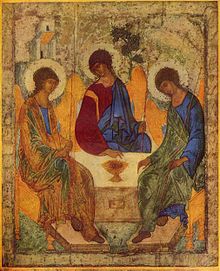
Aspects of the iconography borrow from the pre-Christian Roman and Hellenistic art. Henry Chadwick wrote, "In this instinct there was a measure of truth. The representations of Christ as the Almighty Lord on his judgment throne owed something to pictures of Zeus. Portraits of the Mother of God were not wholly independent of a pagan past of venerated mother-goddesses. In the popular mind the saints had come to fill a role that had been played by heroes and deities."[45]
Icons can be found adorning the walls of churches and often cover the inside structure completely.[46] Most Eastern Orthodox homes have an area set aside for family prayer, usually an eastern facing wall, where are hung many icons. Icons have been part of Orthodox Christianity since the beginning of the church.[47]
Iconostasis
[edit]
An iconostasis, also called the templon, is a wall of icons and religious paintings, separating the nave from the sanctuary in a church. Iconostasis also refers to a portable icon stand that can be placed anywhere within a church. The modern iconostasis evolved from the Byzantine templon in the 11th century. The evolution of the iconostasis probably owes a great deal to 14th-century Hesychast mysticism and the wood-carving genius of the Russian Orthodox Church.
The first ceiling-high, five-leveled Russian iconostasis was designed by Andrey Rublyov in the cathedral of the Dormition in Vladimir in 1408.
Cross
[edit]

The small top crossbar represents the sign that Pontius Pilate nailed above Christ's head. It often is inscribed with an acronym, "INRI", Latin for "Jesus of Nazareth, King of the Jews" or "INBI", Greek Ἰησοῦς ὁ Ναζωραῖος ὁ βασιλεύς τῶν Ἰουδαίων for "Jesus of Nazareth, King of the Jews".[48]
Other crosses associated with the Eastern Orthodox Church are the more traditional single-bar crosses, budded designs, the Greek cross, the Latin cross, the Jerusalem cross (cross pattée), Celtic crosses, and others.[49] A common symbolism of the slanted foot stool is the foot-rest points up, toward Heaven, on Christ's right hand-side, and downward, to Hades, on Christ's left. "Between two thieves Thy Cross did prove to be a balance of righteousness: wherefore one of them was dragged down to Hades by the weight of his blasphemy [the balance points downward], whereas the other was lightened of his transgressions unto the comprehension of theology [the balance points upward]. O Christ God, glory to Thee."[50]
Art and architecture
[edit]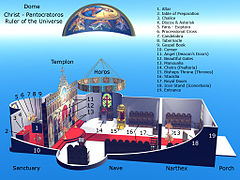
The Archdiocesan Cathedral of the Holy Trinity on New York City's Upper East Side is the largest Eastern Orthodox Christian church in the Western Hemisphere.[51]
Local customs
[edit]
Locality is also expressed in regional terms of churchly jurisdiction, which is often also drawn along national lines. Many Orthodox churches adopt a national title (e.g. Albanian Orthodox, Bulgarian Orthodox, Georgian Orthodox, Greek Orthodox, Romanian Orthodox, Russian Orthodox, Serbian Orthodox, Ukrainian Orthodox, etc.) and this title can identify which language is used in services, which bishops preside, and which of the typica is followed by specific congregations. In the Middle East, Orthodox Christians are usually referred to as Rum ("Roman") Orthodox, because of their historical connection with the Eastern Roman (Byzantine) Empire.[52]
Holy mysteries (sacraments)
[edit]Those things which in the West are often termed sacraments or sacramentals are known among the Eastern Orthodox as the "sacred mysteries". While the Roman Catholic Church numbers seven sacraments, and many Protestant groups list two (baptism and the Eucharist) or even none, the Eastern Orthodox do not limit the number. However, for the sake of convenience, catechisms often speak of the seven great mysteries. Among these are Holy Communion (the most direct connection), baptism, Chrismation, confession, unction, matrimony, and ordination. But the term also properly applies to other sacred actions such as monastic tonsure or the blessing of holy water, and involves fasting, almsgiving, or an act as simple as lighting a candle, burning incense, praying or asking God's blessing on food.[53]
Baptism
[edit]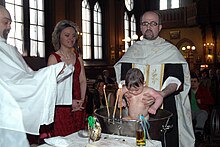
Baptism is the mystery which transforms the old and sinful person into a new and pure one; the old life, the sins, any mistakes made are gone and a clean slate is given. Through baptism a person is united to the Body of Christ by becoming a member of the Eastern Orthodox Church. During the service, water is blessed. The catechumen is fully immersed in the water three times in the name of the Trinity. This is considered to be a death of the "old man" by participation in the crucifixion and burial of Christ, and a rebirth into new life in Christ by participation in his resurrection.[54]
Properly, the mystery of baptism is administered by bishops and priests; however, in emergencies any Eastern Orthodox Christian can baptise.[55]
Chrismation
[edit]Chrismation (sometimes called confirmation) is the mystery by which a baptised person is granted the gift of the Holy Spirit through anointing with Holy Chrism.[56][57] It is normally given immediately after baptism as part of the same service, but is also used to receive lapsed members of the Eastern Orthodox Church.[58] As baptism is a person's participation in the death and resurrection of Christ, so Chrismation is a person's participation in the coming of the Holy Spirit at Pentecost.[59]
A baptised and chrismated Eastern Orthodox Christian is a full member of the church and may receive the Eucharist regardless of age.[59]
Anointing with chrism substitutes for the laying-on of hands described in the New Testament.[60]
Holy Communion (Eucharist)
[edit]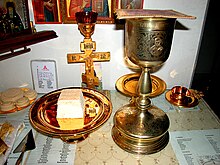
Communion is given only to baptised and chrismated Eastern Orthodox Christians who have prepared by fasting, prayer and confession. The priest administers the gifts with a spoon, called a "cochlear", directly into the recipient's mouth from the chalice.[61] From baptism young infants and children are carried to the chalice to receive holy communion.[59]
Repentance (Confession)
[edit]There are many different practices regarding how often Eastern Orthodox Christians should go to confession. Some Patriarchates advise confession before each reception of Holy Communion, others advise confessing during each of the four fasting periods (Great Lent, Nativity Fast, Apostles' Fast and Dormition Fast), and there are many additional variants.[62]
Marriage
[edit]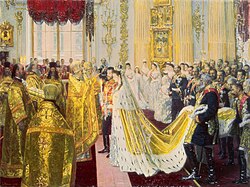
From the Orthodox perspective, marriage is one of the holy mysteries or sacraments. As well as in many other Christian traditions, for example in Catholicism, it serves to unite a woman and a man in eternal union and love before God, with the purpose of following Christ and his Gospel and raising up a faithful, holy family through their holy union.[63][64] The church understands marriage to be the union of one man and one woman, and certain Orthodox leaders have spoken out strongly in opposition to the civil institution of same-sex marriage.[65][66]
Jesus said that "when they rise from the dead, they neither marry nor are given in marriage, but are like angels in heaven" (Mk 12:25). For the Orthodox Christian this passage should not be understood to imply that Christian marriage will not remain a reality in the Kingdom, but points to the fact that relations will not be "fleshy", but "spiritual".[67] Love between wife and husband, as an icon of relationship between Christ and Church, is eternal.[67]
The church does recognise that there are rare occasions when it is better that couples do separate, but there is no official recognition of civil divorces. For the E. Orthodox, to say that marriage is indissoluble means that it should not be broken, the violation of such a union, perceived as holy, being an offense resulting from either adultery or the prolonged absence of one of the partners. Thus, permitting remarriage is an act of compassion of the church towards sinful man.[68]
Holy orders
[edit]
Widowed priests and deacons may not remarry and it is common for such members of the clergy to retire to a monastery (see clerical celibacy). This is also true of widowed wives of clergy, who do not remarry and become nuns when their children are grown. Only men are allowed to receive holy orders, although deaconesses historically had both liturgical and pastoral functions within the church.[69]
In 2016, the Patriarchate of Alexandria decided to reintroduce the order of deaconess.[70][71] In February 2017, Patriarch Theodore II consecrated five women to be deacons within the Patriarchate of Alexandria.[72]
Distribution
[edit]
Eastern Orthodoxy is the predominant religion in Russia (77%),[73][74][75] where roughly half the world's Eastern Orthodox Christians live. The religion is also heavily concentrated in the rest of Eastern Europe, where it is the majority religion in Ukraine (65.4%[76]–77%),[77] Romania (81%),[78] Belarus (48%[79]–73%[80]), Greece (98%),[78] Serbia (86%),[78] Bulgaria (86%),[78] Moldova (90%),[78] Georgia (83%),[78] North Macedonia (70%),[78] Cyprus (80%)[78] and Montenegro (73%);[78] it is also predominant in the disputed territories of Abkhazia, South Ossetia and Transnistria.
Significant minorities are present in several European countries, such as: Bosnia and Herzegovina (31%),[78] Latvia (24%), Estonia (24%), Albania (7–10%),[81] Lithuania (4%), Croatia (4%), Slovenia (2%), Germany (2%)[82] and Finland (1.5%). In the former Soviet republics of Central Asia, Eastern Orthodoxy constitutes the dominant religion in northern Kazakhstan, representing 17.9% of the population of the region,[83] and is also a significant minority in Kyrgyzstan (10%), Turkmenistan (4%), Uzbekistan (3%), Azerbaijan (2%),[78] and Tajikistan (1%).
Significant Eastern Orthodox populations in the Eastern Mediterranean (primarily Greek Orthodox) are in Lebanon (8%),[84] Syria (5–8%), Jordan (2–5%),[85][86] State of Palestine (1%–2.5%),[87] and Israel (1–2%).[88][89]
See also
[edit]- Orthodoxy
- Eastern Orthodox theology
- Eastern Orthodox liturgical calendar
- Revised Julian calendar
- Western Rite Orthodoxy
- Russian Orthodox cross
- Ushkovayzet
- List of Eastern Orthodox saints
Notes
[edit]- ^ Including the deuterocanonical books
References
[edit]Citations
[edit]- ^ a b Holt, Andrew (2012) [2011]. "Byzantine Christianity". The Encyclopedia of Christian Civilization. Chichester, West Sussex: Wiley-Blackwell. doi:10.1002/9780470670606.wbecc0212. ISBN 9780470670606.
Byzantine Christianity originated in the Eastern Roman Empire where it evolved concurrently with the emerging Byzantine state. It was the dominant form of Eastern Christianity throughout the Middle Ages and during this period it developed a complex theological system with unique spiritual practices. Byzantine Christianity's fortunes were in many ways tied to the Byzantine state, because when the empire experienced expansion and heightened influence so did the faith. [...] Although the empire eventually fell under the weight of centuries of Islamic aggression, much of Byzantine Christianity has survived in the modern Eastern Orthodox churches.
- ^ McAuliffe, Garrett (2008). Culturally Alert Counseling: A Comprehensive Introduction. SAGE Publishing. p. 532. ISBN 978-1-4129-1006-4.
About one-third of the world's population is considered Christian and can be divided into three main branches: (1) Roman Catholicism (the largest coherent group, representing over one billion baptized members); (2) Orthodox Christianity (including Eastern Orthodoxy and Oriental Orthodoxy); and (3) Protestantism (comprising many denominations and schools of thought, including Anglicanism, Reformed, Presbyterianism, Lutheranism, Methodism, Evangelicalism, and Pentecostalism).
- ^ Mirola, William; Monahan, Susanne C. (2016). Religion Matters: What Sociology Teaches Us About Religion In Our World. London and New York City: Routledge. ISBN 978-1-317-34451-3.
Orthodox Churches represent one of the three major branches of Christianity, along with Roman Catholicism and Protestantism.
- ^ Richters, Katja. The Post-Soviet Russian Orthodox Church: Politics, Culture and Greater Russia (2014)
- ^ Fr. Lawrence Farley (11 July 2012). "The Filioque Clause". Orthodox Church in America. Archived from the original on 26 October 2015. Retrieved 8 March 2022.
- ^ Ware 1993, pp. 208–211.
- ^ a b c d Theokritoff, Elizabeth (2010) [2008]. "Part I: Doctrine and Tradition – Creator and creation". In Cunningham, Mary B.; Theokritoff, Elizabeth (eds.). The Cambridge Companion to Orthodox Christian Theology. Cambridge and New York: Cambridge University Press. pp. 63–77. doi:10.1017/CCOL9780521864848.005. ISBN 9781139001977. Archived from the original on 21 September 2023. Retrieved 4 February 2022.
- ^ Ware 1993, p. 202.
- ^ Ware 1993, pp. 67–69.
- ^ Hierotheos 1998, pp. 128–130.
- ^ Matusiak, Fr. John. "Original Sin". Orthodox Church in America. Archived from the original on 7 June 2011. Retrieved 23 May 2014.
- ^ Mastrantonis, George (12 August 2015). "The Fundamental Teachings of the Eastern Orthodox Church". Greek Orthodox Archdiocese of America. Retrieved 6 August 2024.
- ^ "The Orthodox Faith - Volume I - Doctrine and Scripture - The Symbol of Faith - Resurrection". www.oca.org. Retrieved 6 August 2024.
- ^ Hierotheos 1998, pp. 234–237, (241=Glossary).
- ^ George 2006, p. 34.
- ^ Oxford Dict Christian Church & 3rd ed.
- ^ Fitzgerald, Fr. Thomas (2014). "Spirituality". Greek Orthodox Archdiocese of America. Archived from the original on 29 March 2014. Retrieved 15 May 2014.
- ^ George 2006, p. 21.
- ^ Hierotheos 1998, pp. 25–30.
- ^ Hierotheos 1998, p. 23.
- ^ Gregory of Nyssa (1978). The life of Moses. Transl., introduction and notes by Abraham J. Malherbe and Everett Ferguson; preface by John Meyendorff. New York: Paulist Press. p. 59. ISBN 978-0-8091-2112-0. Retrieved 4 October 2013.
- ^ Ware 1993, pp. 257–258.
- ^ Ware 1993, p. 234.
- ^ The Longer Catechism of The Orthodox, Catholic, Eastern Church, an Orthodox catechism from 1830, by Metropolitan Philaret. Start with item 366 or 372. Archived 3 July 2007 at the Wayback Machine
- ^ a b c Rose, Father Seraphim, The Soul After Death, St. Herman Press, Platina, CA, c. 1980
- ^ The Longer Catechism, Item 377. Archived 3 July 2007 at the Wayback Machine
- ^ Di Lella, Alexander A. (2002). "The Textual History of Septuagint-Daniel and Theodotion Daniel". In Collins, John Joseph; Flint, Peter W.; VanEpps, Cameron (eds.). The Book of Daniel: Composition and Reception. Vol. 2. Brill. p. 586. ISBN 9780391041288. Archived from the original on 21 September 2023. Retrieved 4 February 2022.
- ^ Geisler, Norman L.; Nix, William E. (2012). From God to Us: How We Got Our Bible. Moody Publishers. ISBN 9780802428820.
- ^ Ware 1991, p. 209.
- ^ Ware 1991, p. 209 (quoting St. John Chrysostom): "It is impossible for a man to be saved if he does not read the Scriptures.".
- ^ Pomazansky, Michael, Orthodox Dogmatic Theology, pp. 33–34
- ^ S.T. Kimbrough (2005). Orthodox And Wesleyan Scriptural Understanding And Practice. St Vladimir's Seminary Press. p. 23. ISBN 978-0-88141-301-4. Retrieved 20 February 2016.
- ^ Orthodox Study Bible, St. Athanasius Academy of Theology, 2008, p. 778, commentary
- ^ Ware, Bishop Kallistos (Timothy), How to Read the Bible Archived 1 February 2022 at the Wayback Machine, retrieved 11 June 2013
- ^ a b c d Ware 1991, pp. 210–215
- ^ Ware 1993, pp. 195–196.
- ^ Letter of 1718, in George Williams, The Orthodox Church of the East in the 18th Century, p. 17
- ^ Bible: Matthew 16:19
- ^ Vladimir Lossky, Tradition is the Life of the Holy Spirit in the Church.
- ^ Ware 1991, p. 205.
- ^ Ware 1991, p. 213.
- ^ Bible: 1 Cor 1:10
- ^ "The Five Cycles". Orthodox Worship. The Diocese of Eastern Pennsylvania, Orthodox Church in America. Archived from the original on 13 July 2015. Retrieved 24 June 2015.
- ^ Ware 1993, p. 238.
- ^ Henry Chadwick, The Early Church, 283.
- ^ Ware 1993, p. 271.
- ^ "Icons – Orthodox Christianity – Religion Facts". Archived from the original on 22 March 2015. Retrieved 5 March 2015.
- ^ Binz, Stephen J. (2004). The Names of Jesus. New London: Twenty-Third Publications. pp. 81–82. ISBN 9781585953158.
- ^ A good explanation of the 3-bar cross was written by Orthodox symbologist Alexander Roman and can be found at http://www.ukrainian-orthodoxy.org/questions/2010/threeBarCross.php Archived 1 February 2022 at the Wayback Machine
- ^ "An Explanation of the Traditional Russian Orthodox Three-bar Cross". www.synaxis.info. Archived from the original on 4 July 2015. Retrieved 17 October 2015.
- ^ Thomas E. FitzGerald (1998). The Orthodox Church: Student Edition. Greenwood Publishing. ISBN 978-0-275-96438-2. Archived from the original on 21 September 2023. Retrieved 5 January 2013.
- ^ Binns 2002, p. 3.
- ^ Ware 1993, pp. 274–277.
- ^ Ware 1993, pp. 277–278.
- ^ Ware 1993, p. 278.
- ^ Fr. Thomas Hopko (1981). "The Orthodox Faith". St. Vladimir's Seminary Press. Archived from the original on 25 October 2011. Retrieved 11 November 2013.
- ^ Ware 1993, pp. 278–279.
- ^ Harakas 1987, pp. 56–57.
- ^ a b c Ware 1993, p. 279
- ^ Harakas 1987, p. 57.
- ^ Ware 1993, p. 287.
- ^ "Confession, Communion and Preparation for Communion". Orthodox Christian Comment. 31 August 2007. Archived from the original on 20 November 2019. Retrieved 11 April 2016.
- ^ "Letter to Families by Pope John Paul II". Archived from the original on 5 April 2011.
- ^ John Meyendorff (1975). Marriage: An Orthodox Perspective. St. Vladimir's Seminary Press. p. 13. ISBN 978-0-913836-05-7. Archived from the original on 21 September 2023. Retrieved 20 February 2016.
- ^ "Statement of Orthodox Christian Bishops" (PDF). Archived from the original (PDF) on 10 June 2011.
- ^ "OCA Reaffirms SCOBA Statement in Wake of Massachusetts Same-Sex Marriage Ruling". 17 May 2004. Archived from the original on 22 June 2010. Retrieved 4 August 2010.
- ^ a b John Meyendorff (1975). Marriage: An Orthodox Perspective. St. Vladimir's Seminary Press. p. 18. ISBN 978-0-913836-05-7. Archived from the original on 21 September 2023. Retrieved 20 February 2016.
- ^ Mgr. Athenagoras Peckstadt, Bishop of Sinope (18 May 2005). "Marriage, Divorce and Remarriage in the Orthodox Church: Economia and Pastoral Guidance". The Orthodox research Institute. Archived from the original on 20 January 2009. Retrieved 19 November 2008.
- ^ Karras, Valerie A. (June 2004). "Female Deacons in the Byzantine Church". Church History. 73 (2): 272–316. doi:10.1017/S000964070010928X. ISSN 0009-6407. S2CID 161817885.
- ^ "Orthodox Church debate over women deacons moves one step closer to reality". Religion News Service. 9 March 2017. Archived from the original on 12 November 2021. Retrieved 12 November 2021.
- ^ "Second Day of Deliberations of the Holy Synod of the Patriarchate of Alexandria". patriarchateofalexandria.com. Archived from the original on 22 December 2016. Retrieved 12 November 2021.
Regarding the issue of the institution of Deaconesses, it was decided to revive this and a tripartite committee of Hierarchs was appointed for a detailed consideration of the subject.
- ^ "Orthodox move for women deacons is 'revitalization' not 'innovation'". National Catholic Reporter. 30 November 2017. Archived from the original on 26 March 2023. Retrieved 12 November 2021.
- ^ "VTSIOM". Archived from the original on 29 September 2020. Retrieved 4 February 2022.
- ^ "Ценности: религиозность / ФОМ". fom.ru. Archived from the original on 31 July 2020. Retrieved 31 August 2022.
- ^ There is no official census of religion in Russia, and estimates are based on surveys only. In August 2012, ARENA Archived 12 June 2018 at the Wayback Machine determined that about 48% of Russians are Christians (including Orthodox, Catholic, Protestant, and non-denominational), which is slightly less than an absolute 50%+ majority. However, later that year the Levada Center Archived 31 December 2012 at the Wayback Machine determined that 76% of Russians are Christians, and in June 2013 the Public Opinion Foundation Archived 15 April 2020 at the Wayback Machine determined that 65% of Russians are Christians. These findings are in line with Pew Archived 4 October 2018 at the Wayback Machine's 2010 survey, which determined that 73.6% of Russians are Christians, with VTSIOM Archived 29 September 2020 at the Wayback Machine's 2010 survey (~77% Christian), and with Ipsos MORI Archived 17 January 2013 at the Wayback Machine's 2011 survey (69%).
- ^ РЕЛІГІЯ, ЦЕРКВА, СУСПІЛЬСТВО І ДЕРЖАВА: ДВА РОКИ ПІСЛЯ МАЙДАНУ (Religion, Church, Society and State: Two Years after Maidan) Archived 22 April 2017 at the Wayback Machine, 2016 report by Razumkov Center in collaboration with the All-Ukrainian Council of Churches. pp. 27–29.
- ^ "Pewforum: Christianity (2010)" (PDF). Archived from the original (PDF) on 5 August 2013. Retrieved 14 May 2014.
- ^ a b c d e f g h i j k "Field Listing :: Religions". The World Factbook. CIA. Archived from the original on 13 June 2007. Retrieved 22 May 2014.
- ^ "Religion and denominations in the Republic of Belarus by the Commissioner on Religions and Nationalities of the Republic of Belarus from November 2011" (PDF). Archived (PDF) from the original on 14 October 2017. Retrieved 4 February 2022.
- ^ "Religious Belief and National Belonging in Central and Eastern Europe". 10 May 2017. Archived from the original on 31 August 2022. Retrieved 31 August 2022.
- ^ Religion in Albania#Religious demography
- ^ "Germany Religions – Demographics". indexmundi.com. Retrieved 22 November 2023.
- ^ Table 28, 2013 Census Data – QuickStats About Culture and Identity – Tables Archived 22 November 2017 at the Wayback Machine.
- ^ Lebanon – International Religious Freedom Report 2010 U.S. Department of State. Retrieved on 14 February 2010.
- ^ "Jordan Religions – Demographics". indexmundi.com. Archived from the original on 17 August 2022. Retrieved 17 September 2022.
- ^ Vela, Justin (14 February 2015). "Jordan: The safe haven for Christians fleeing ISIL". The National. Archived from the original on 20 September 2022. Retrieved 17 September 2022.
- ^ "West Bank". Central Intelligence Agency. 10 August 2022. Archived from the original on 22 July 2021. Retrieved 4 February 2022 – via CIA.gov.
- ^ "The Christian communities in Israel – May 2014". 17 October 2015. Archived from the original on 17 October 2015. Retrieved 17 September 2022.
- ^ "Israel", The World Factbook, Central Intelligence Agency, 2 September 2022, archived from the original on 13 September 2021, retrieved 17 September 2022
Sources
[edit]- St. Athanasius (1982), On the Incarnation [De Incarnatione Verbi Dei] (PDF), Crestwood, NY: St. Vladimir's Orthodox Theological Seminary, ISBN 978-0-913836-40-8, retrieved 3 June 2014 (Introduction by C. S. Lewis)
- Binns, John (2002), An Introduction to the Christian Orthodox Churches, Cambridge University Press, ISBN 978-0-521-66738-8, retrieved 2 June 2014
- Chrysostom, St. John (c. 400), Paschal Homily, Wikisource, retrieved 20 February 2016
- Cleenewerck, Laurent (2009), His Broken Body: Understanding and Healing the Schism Between the Roman Catholic and Eastern Orthodox Churches, Washington, DC: Euclid University Press, ISBN 978-0-615-18361-9, retrieved 2 June 2014 [self-published source]
- De Vie, D. Charles (1945), The Eastern Orthodox-Catholic Church and the Anglican Church: Their Union, Tufts University, OCLC 190830032, archived from the original on 3 September 2015, retrieved 2 June 2014
- Diamond, Larry Jay; Plattner, Marc F.; Costopoulos, Philip J., eds. (2005), World Religions and Democracy, Johns Hopkins University and the National Endowment for Democracy, ISBN 978-0-8018-8080-3, OCLC 58807255
- Fitzgerald, Thomas E. (30 September 1998), The Orthodox Church, Westport, CT: Praeger Publishers, ISBN 978-0-275-96438-2, retrieved 2 June 2014
- Fortescue, Adrian (1908), The Orthodox Eastern Church (2nd ed.), London: Catholic Truth Society / University of Virginia (published 11 December 2008), retrieved 2 June 2014
- Archimandrite George (2006), Theosis: The True Purpose of Human Life (PDF) (4th ed.), Mount Athos, Greece: Holy Monastery of St. Gregorios, ISBN 978-960-7553-26-3, retrieved 2 June 2014
- Greek Orthodox Church (1875), The marriage service of the Holy Orthodox Catholic Church, trans. from Greek by Rev. Athanasius Richardson, London: A.R. Mowbray & Co., retrieved 2 June 2014
- Edwards, Mark J. (2009). Catholicity and Heresy in the Early Church. Farnham: Ashgate Publishing. ISBN 9780754662914.
- Harakas, Stanley S. (1 May 1987), The Orthodox Church: 455 Questions and Answers, Light & Life Publishing Company, Minneapolis, MN, ISBN 978-0-937032-56-5
- Hardon, John (1981), Catholic Catechism, New York: Doubleday, ISBN 978-0-385-08045-3, retrieved 2 June 2014
- Hayward, C.J.S. (2016). The Best of Jonathan's Corner. Wheaton, IL: C.J.S. Hayward Publications. ISBN 978-1-4782-1991-0.
- Hierotheos, Metropolitan of Nafpaktos (1998), The Mind of the Orthodox Church, Levadia, Greece: Birth of the Theotokos Monastery, ISBN 978-960-7070-39-5
- Leith, John H. (1982), Creeds of the Churches (3rd ed.), Westminster: John Knox Press, ISBN 978-0-8042-0526-9, retrieved 2 June 2014
- Losch, Richard R. (3 May 2002), The Many Faces of Faith: A Guide to World Religions and Christian Traditions, Wm. B. Eerdmans, ISBN 978-0-8028-0521-8, retrieved 2 June 2014
- Meyendorff, John (1966). Orthodoxy and Catholicity. New York: Sheed & Ward.
- Meyendorff, John (2000) [1975]. Marriage – An Orthodox Perspective (Revised Third ed.). Yonkers, New York: Saint Vladimir's Orthodox Theological Seminary#St. Vladimir’s Seminary Press (SVS Press). ISBN 0-913836-05-2.
- Meyendorff, John (1975) [1969]. Christ in Eastern Christian Thought (2nd ed.). Crestwood, NY: St. Vladimir's Seminary Press. ISBN 9780913836279.
- Meyendorff, John (1978). Living Tradition: Orthodox Witness in the Contemporary World. Crestwood, NY: St. Vladimir's Seminary Press. ISBN 9780913836279.
- Meyendorff, John (1982). The Byzantine Legacy in the Orthodox Church. Crestwood, NY: St. Vladimir's Seminary Press. ISBN 9780913836903.
- Meyendorff, John (1983). Catholicity and the Church. Crestwood, NY: St. Vladimir's Seminary Press. ISBN 9780881410068.
- Meyendorff, John (1983) [1974]. Byzantine Theology: Historical Trends and Doctrinal Themes (Revised 2nd ed.). New York: Fordham University Press. ISBN 9780823209675.
- Meyendorff, John (1989). Imperial unity and Christian divisions: The Church 450-680 A.D. Crestwood, NY: St. Vladimir's Seminary Press. ISBN 9780881410556.
- Meyendorff, John (1996). Rome, Constantinople, Moscow: Historical and Theological Studies. Crestwood, NY: St. Vladimir's Seminary Press. ISBN 9780881411348.
- Meyendorff, John (1996) [1962]. The Orthodox Church: Its Past and Its Role in the World Today (Revised 4th ed.). Crestwood, NY: St. Vladimir's Seminary Press. ISBN 9780913836811.
- Nielsen, Stevan L.; Johnson, W. Brad; Ellis, Albert (1 May 2001), Counseling and Psychotherapy With Religious Persons: A Rational Emotive Behavior Therapy Approach, Taylor & Francis, ISBN 978-1-4106-0070-7, retrieved 2 June 2014
- Orthodox Eastern Church (1909), The Shorter Catechism of the Eastern Orthodox Catholic Church, Rincon Publishing Co., retrieved 2 June 2014
- Ware, Bishop Kallistos (Timothy) (1991) [first published 1964], The Orthodox Church (revised original ed.), New York: Penguin Books, ISBN 978-0-14-013529-9
- Ware, Bishop Kallistos (Timothy) (29 April 1993), The Orthodox Church (new ed.), New York: Penguin Books, ISBN 978-0-14-014656-1
- Ware, Bishop Kallistos (Timothy) (2015). The Orthodox Church (third ed.). London, UK: Penguin Books. ISBN 9780141980638.
- The Great Book of Needs: Expanded and Supplemented (Volume 1): The Holy Mysteries. Translated by Saint Tikhon's Monastery. South Canaan, Pennsylvania: Saint Tikhon's Seminary Press (published 2000). 1998. ISBN 9781878997562.
Tertiary reference works
[edit]- American Heritage Dictionary of the English Language (5th ed.), Houghton Mifflin Harcourt, 2014, ISBN 978-0-547-04101-8, retrieved 28 May 2014
- Columbia Encyclopedia (6th ed.), Columbia Univ. Press, June 2000, ISBN 978-0-7876-5015-5, retrieved 2 June 2014
- Encyclopædia Britannica Online, 2014, retrieved 29 May 2014
- Encyclopedia of Christianity, vol. 3, Wm. B. Eerdmans, 2003, ISBN 978-0-8028-2415-8, retrieved 28 May 2014
- Encyclopedia of the Modern Middle East & North Africa (2nd ed.), Macmillan Reference US, August 2004, ISBN 978-0-02-865769-1, archived from the original on 2 June 2014, retrieved 28 May 2014
- Encyclopedia of World Religions, Concord Pub., 25 October 2006, ISBN 978-1-60136-000-7, retrieved 28 May 2014
- Encyclopedia of World Religions (revised ed.), Infobase Publishing, 2007, ISBN 978-0-8160-6141-9, retrieved 30 May 2014
- Merriam-Webster's Encyclopedia of World Religions, Merriam-Webster, September 1999, ISBN 978-0-87779-044-0, retrieved 30 May 2014
- Merriam-Webster Online Dictionary, archived from the original on 31 May 2014, retrieved 30 May 2014
- Oxford Dictionary of the Christian Church (3rd rev. ed.), Oxford University Press, 2005, ISBN 978-0-19-280290-3
Further reading
[edit]- Adeney, Walter F. (1908). The Greek and Eastern Churches (PDF). New York: Charles Scribner's Sons.
- Buxhoeveden, Daniel; Woloschak, Gayle, eds. (2011). Science and the Eastern Orthodox Church (1st ed.). Farnham: Ashgate. ISBN 9781409481614. Archived from the original on 21 September 2023. Retrieved 4 February 2022.
- Dvornik, Francis (1948). The Photian Schism: History and Legend. Cambridge, UK: Cambridge University Press.
- Erickson, John H. (1991). The Challenge of Our Past: Studies in Orthodox Canon Law and Church History. Crestwood, NY: St. Vladimir's Seminary Press. ISBN 9780881410860. Archived from the original on 21 September 2023. Retrieved 4 February 2022.
- Erickson, John H. (1992). "The Local Churches and Catholicity: An Orthodox Perspective". The Jurist. 52: 490–508. Archived from the original on 4 November 2020. Retrieved 4 February 2022.
- Fairbairn, Donald (2002). Eastern Orthodoxy through Western Eyes. Louisville, KY: Westminster John Knox Press. ISBN 9780664224974. Archived from the original on 21 September 2023. Retrieved 4 February 2022.
- FitzGerald, Thomas (2007). "Eastern Christianity in the United States". The Blackwell Companion to Eastern Christianity. Malden, MA: Blackwell Publishing. pp. 269–279. ISBN 9780470766392. Archived from the original on 21 September 2023. Retrieved 4 February 2022.
- Hussey, Joan M. (1986). The Orthodox Church in the Byzantine Empire. Oxford: Clarendon Press. ISBN 9780198269014. Archived from the original on 21 September 2023. Retrieved 4 February 2022.
- Krindatch, Alexei D. ed., Atlas of American Orthodox Christian Churches (Holy Cross Orthodox Press, 2011) online Archived 6 October 2016 at the Wayback Machine.
- Lossky, Vladimir (1957). The Mystical Theology of the Eastern Church (1. ed.). London: J. Clarke. ISBN 9780227675366. Archived from the original on 21 September 2023. Retrieved 4 February 2022.
- Mascall, Eric Lionel (1958). The Recovery of Unity: A Theological Approach. London: Longmans.
- McGuckin, John Anthony (2008). The Orthodox Church: An Introduction to its History, Doctrine, and Spiritual Culture (1. ed.). Malden, MA: Blackwell Publishing. ISBN 9781405150668.
- McGuckin, John Anthony, ed. (2011). The Encyclopedia of Eastern Orthodox Christianity. Vol. 1. Malden, MA: Wiley-Blackwell. ISBN 9781405185394. Archived from the original on 21 September 2023. Retrieved 4 February 2022.
- McGuckin, John Anthony, ed. (2011). The Encyclopedia of Eastern Orthodox Christianity. Vol. 2. Malden, MA: Wiley-Blackwell. ISBN 9781405185394. Archived from the original on 21 September 2023. Retrieved 4 February 2022.
- Obolensky, Dimitri (1974) [1971]. The Byzantine Commonwealth: Eastern Europe, 500–1453. London: Cardinal. ISBN 9780351176449. Archived from the original on 21 September 2023. Retrieved 4 February 2022.
- Ostrogorsky, George (1956). History of the Byzantine State. Oxford: Basil Blackwell. Archived from the original on 23 April 2023. Retrieved 4 February 2022.
- Paraskevas, J. E.; Reinstein, F. (1969). The Eastern Orthodox Church: A Brief History. Washington: El Greco Press.
- Runciman, Steven (1968). The Great Church in Captivity: A Study of the Patriarchate of Constantinople from the Eve of the Turkish Conquest to the Greek War of Independence (1st ed.). Cambridge: Cambridge University Press. ISBN 9780521071888. Archived from the original on 21 September 2023. Retrieved 4 February 2022.
- Scouteris, Constantine, A Brief Outline of the Orthodox Church, Ἐκκλησιαστικός Φάρος, 65 (2004), pp. 60–75. Archived 3 February 2022 at the Wayback Machine
